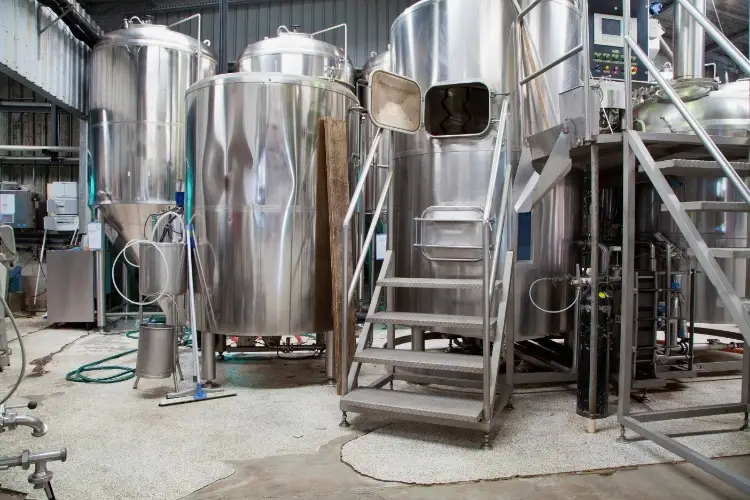If you are really passionate about homebrewing and want to consider starting your own business, I offer an overview on how to get started with your own microbrewery.
There are two types, brewpubs and microbreweries. A brewpub is smaller, perhaps 3-7 barrels (1 US barrel equals 31 gallons). A microbrewery is larger, perhaps from 10 bbls. to 30 bbls. and up. The barrelage is measured by the brew kettle, or how much wort you produce in one batch.
I lived in Asheville, NC for 18 years and was active in the early brewing scene there from 1997-2006. I founded two breweries there: Green Man Brewing Company and the second was French Broad Brewing Company.
Here is a list and description of the key microbrewery equipment that you will need to get started.
Microbrewery Equipment List
1) Grain mill
If you buy a grain mill, a three-roller mill is best but much more expensive. The malt husk of the grain needs to be evenly split and largely intact to properly filter the mash during the sparge. The three rollers give the best results.
You can buy pre-milled malt or crack your own for freshness and cost-savings. It is worth the investment and will save money. An augur may be added to move your malt directly into the mash tun, ultimately labor-saving.
2) Mash-Lauter system
A mash/ lauter tun (tank or vessel) is your primary piece. In it, you mash your malt and extract your sugar from the raw grain. It will also serve as your lauter (lauter is to wash). After the mash, run a specified amount of water through the mash to bring the volume of the wort up to capacity.
There will be an electric stainless-steel pump for transfer. You will fire the kettle with gas or a steam boiler.
The kettle is just this, a big pot for boiling. It is vented through the ceiling and will be direct-fire with a gas burner or have steam jackets wrapping it. Steam is more efficient.
A hot-liquor tank is for bulk hot water heating. You can live without it but not recommended. Its primary role is to heat water for mashing. It also provides ready water for cleaning the plant. Brewers scrub the inside of tanks with hot caustic washes.
A cold liquor tank is useful, and a luxury. I never had one, sigh. You keep cold water solely for cooling the wort after boiling.
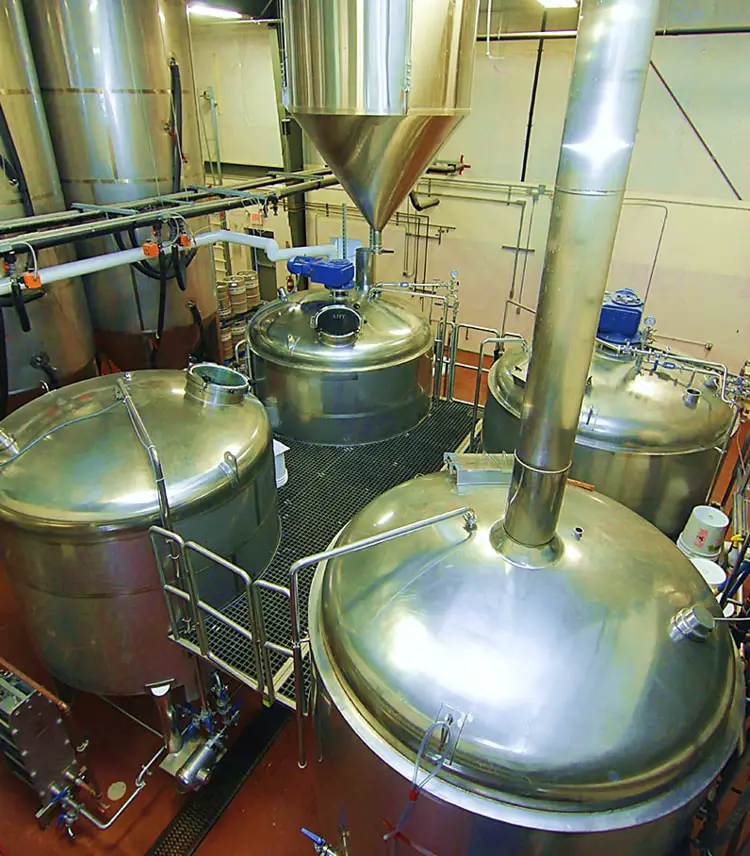
3) Heat exchanger
Your brewhouse pump will transfer your raw wort through a heat exchanger. The heat exchanger is a tall block-shaped device made of layered plates. 200° wort goes in one side, 40° (or ambient) water goes in the other. This counterflow process cools your wort in 30-40 minutes. A cold liquor tank really comes in handy.
There are double-bank heat exchangers that are the most effective. They chill the incoming water with glycol first, possibly eliminating the need for a Cold-Liquor tank.
4) Fermentation systems
Fermenters are the vessels in which raw wort transforms into beer. As seen in the photo, they are cylindroconical. They have a 45-60° cone that facilitates the drop out of solids once fermentation is complete: dead yeast, proteins, hops, and the healthy yeast too. This is to effectively clarify the beer.
This is one of the time-consuming aspects of brewing. Fermentation will last 7-14 days for ales and 21-35 days for lagers. You will need to have ample fermentation equipment set up and ready to store and monitor the progress of your beer.
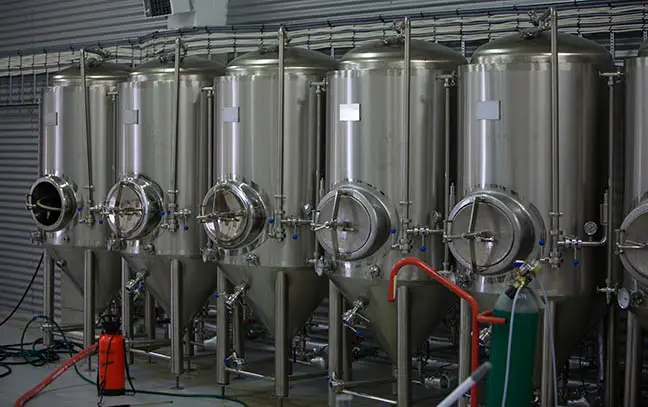
5) Brite tanks
Brite tanks are beer tanks used for storage, conditioning, carbonation, and packaging. They will have dish bottoms and sight glasses (a thin glass tube running the vertical height of the tank). They will also have ports for a carbonation stone and sample cocks (small spigots) for measuring CO2 volumes.
They are cheaper than fermenters as the dish bottoms are single-walled and easier to make than cones.
Brewpubs will serve beer from Brite tanks. In this case, you pay taxes based on the volume in the tank. Production brewers will pay taxes based on what makes it onto the pallet and into the walk-in, whether steel, bottle, or glass package.
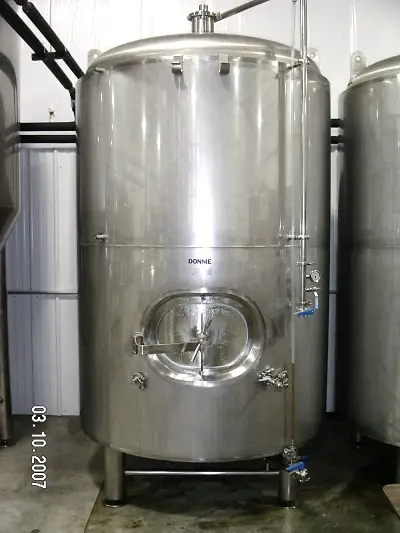
6) Cooling system
Beer tanks have cooling jackets. They are double-walled stainless-steel, insulated and have large sections for the circulation of coolant- propylene glycol.
A glycol chiller has a large reservoir as well as a refrigeration compressor. It keeps the glycol at 28-30° F. As you circulate this through the fermenter or Brite-Tank jackets, the beer is finished, aging, or being prepared for packaging. Glycol chilling keeps the beer stable and inhibits bacteria growth and prepares the beer for sale.
7) Valves and Hoses
You’ll need 100’ plus of 1.5 – 2” Brewers and Vintners sanitary transfer hose. It is not cheap, about $12-20 per foot, depending on the quality and fitting. The sanitary fitting for the ends will be separate. They range from $30 each for a low-quality SS barbed tri-clamp to $150 for a high-quality inlaid dairy fitting with little to no inside lip. (a place for contaminates to hide.
Also, 200’ of ⅜” ID braided reinforced gas hose is needed for cellaring, feeding CO2 and O2 to all corners of the brewery.
Butterfly, ball, pressure, and half a dozen other types of valves are usually included with your equipment. It’s a good idea to have extra.
You can pick up brass and bronze valves at local piping stores. These are usually used for water or gas and not caustic or corrosive chemicals.
8) Refractometer and Hydrometer
There will be many toys and gadgets you prefer or use throughout your day, week or long day’s journey into night. One or two are essential.
Get a good refractometer for brew days. With just 3-4 drops of hot wort, they can tell you the original gravity by volume of your wort. They are not temperature sensitive and accurately measure hot wort.
Once the beer has begun fermenting, a brewer will take gravity readings every 1-3 days. They will need a good professional-grade hydrometer. Unlike homebrew hydrometers, they will often come in sets of two or three. The first measures from 1.000 – 1.030, the second from 1.030 – 1.070, and the third measuring wort from 1.075 and up. This is for absolute accuracy.
Additionally, they will have built-in thermometers. Gravity measurement is accurate and meant to be gauged at about 62 F. If the beer is cold, the thermometer will tell you the adjustment to make.
9) Filtration systems
There are three types of filters to clarify your beer: plate and frame, diatomaceous earth, and centrifuges.
Utilizing a portable pump, run your beer through a clarifying process to get rid of any sediment. You need not always filter but as a commercial brewer, you will have time constraints. Commercial brewers do not often have the luxury of time to make the perfect beer. Clarifying makes it more stable for transport.
You will likely have 2-3 portable pumps in the brewery to assist you in various transfers and processes.
10) Controllers
You will need to have temperature controls set up for your beer tanks. You may also have a centralized control panel for your brewhouse, depending on its level of automation.
A main control panel is optional as there are quality affordable NEMA 4 (waterproof) controllers available that can be mounted directly to the tanks. The brewhouse (production area) switches can all be thrown manually. It depends on your budget and priorities for your brewery that determine what kind of switch system you have.
Controllers can also be viewed as safety measures you can use to halt production and prevent accidents in your facility.
11) CIP tank
You will need a portable CIP (clean-in-pace) tank that you can use for housing your sanitation solution, caustic (alkaline cleaner for organics) wash, and acid washes (largely for mineral build-up). It may have a built-in circulation pump or can be paired with a portable pump.
You can use the vessels themselves as reservoirs, but the portable CIP tank streamlines the process.
With the CIP and pumps, you will sanitize all your production equipment as well as sanitize the other empty tanks so that you can run multiple processes simultaneously: racking, filtering, wort production.
Without the right sanitation equipment and applicable chemicals, you should not even consider getting started with brewing a new batch of beer on-site.
12) Packaging / Kegging line
You will need an automated or semi-automated keg washer. You can fill kegs directly from your Brite tanks. This is a manual operation and still very efficient.
Bottling and canning are labor-intensive and require large amounts of packaging inventory. They are vital however to effectively reach all market segments. Not everyone has space for kegs, even just 5 gallons. Competition has made bottles or cans essential.
Cans often come pre-printed. Bottles may not and will require a labeling machine. This can often be hooked up in line with the filler itself, making a sort of all-in-one filler station.
Many microbreweries and brewpubs use a bar tap for filling growler-style containers by hand. This is cost-effective for to-go beer. At my old Asheville brewery, we built a four-growler filler, connected directly to the beer tank. It only cost about $500 to build and could fill 40 cases an hour- six ½ gallon bottles per case.
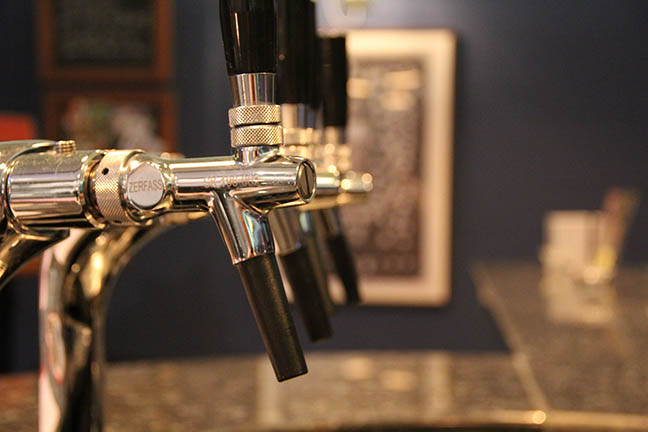
13) Cellar equipment
Cellaring is done in Grundy’s or Bright tanks. They will have ports for carbonation stones. If running a pub brewery, you can carbonate naturally.
Some simple glycerine-filled pressure valves, small gas ball valves and braided hose are all you really need.
Most equipment suppliers will include these things with your tanks. You may or may not save money by purchasing them yourself.
Getting the Equipment Together
The above lists are comprehensive and may be used to build the facility you envision. On any budget, solutions may be found. Back in 2000, I built the French Broad for 140K all-inclusive. It was used equipment and I was the general contractor. With more budget, I would have done some things differently.
There is one company I trust above all others based on business experience and personal relationships. Applied Beverage Tanks – (ABT) have been industry consultants and manufacturers for 30 years. I met them in 1999 when I was undertaking my second brewery, French Broad Brewing Company. I would trust no other.
Our professional arm, KMB Consulting – (KMBC), has partnered exclusively with ABT for tank procurement. Since 1992, ABT has engaged the North American brewing industry and now supplies breweries and distilleries worldwide – over 200 installations in 30 States and 13 countries. With every single one of their clients as a reference, their work speaks volumes.
KMBC is a direct line to their desks. Or feel free to call them. I assure you the prices will be exactly the same.
Please share the customer code, JONAS@KMB, to facilitate communication.
Their site may also be found here.
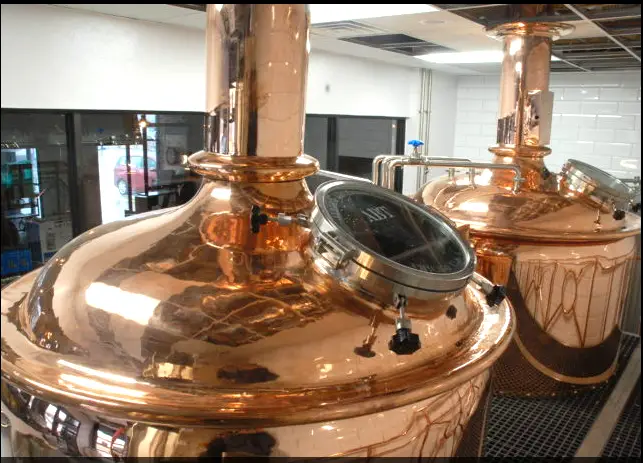
Getting Professional Help
If you are not a professional brewer nor brewed commercially before it will be a good idea to hire a professional brewing consultant to help you through your first 30-90 days.
A consultant will:
- Assist with final walk-throughs of the ATF and city inspectors
- Help scale up your recipes. This is not always a direct translation by weight.
- Learn the new system. Teach you the motions.
- Discuss with you each step of the process and how it is different from a home scale
- Demonstrate fermentation, conditioning, carbonation and packaging using temperature control. This is a major distinction from homebrewing.
- Give potential customers confidence that you are on the right track.
- Perhaps stay on and be your brewmaster
It is vital to have a veteran presence in the brewery when starting out. There will be problems. There always are, no matter how expensive or sophisticated a brewing system may be, nor how perfect the recipe is. Have someone with you that has experience problem-solving. This will cushion the blows of setbacks that inevitably come with any new start-up.
Reach out to us
KMB Consulting can assist you in all of your challenges, large or small. Brewers need support and input. It is an artisanal craft, refined by years in the brewhouse. It is also an uncommonly specialized business.
Interested in a start-up or expansion? From conception to construction and pilot brews, we have the experience.
Today’s brewers have puzzles that need a fresh perspective. I’ve walked in your shoes. I know the victories and struggles that come with the brewer’s life. Reach out to us. No problem is unfixable. Reach us here.
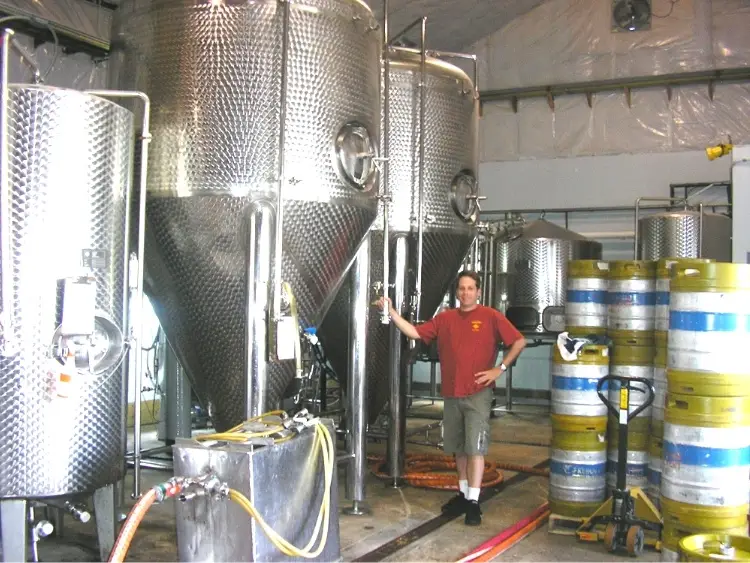
Go to the next article: How Much Does It Cost to Start a Microbrewery?
